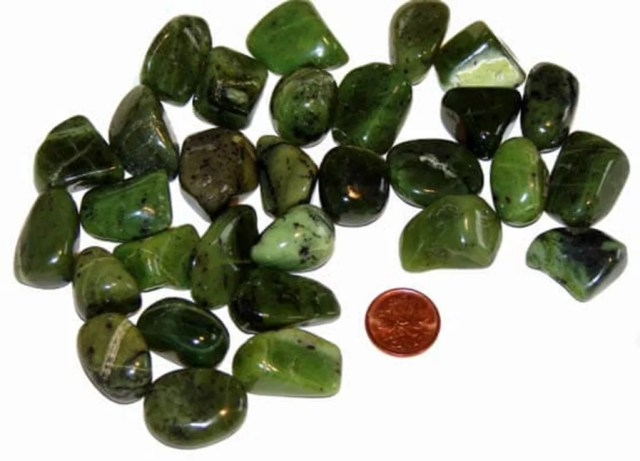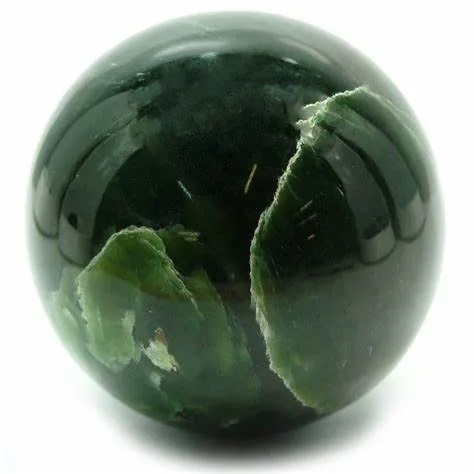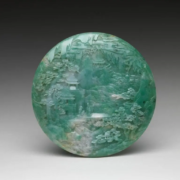Nephrite
Nephrite is a type of mineral that belongs to the jade family, which also includes jadeite. It is a metamorphic rock primarily composed of tremolite or actinolite minerals, and it is known for its unique and desirable qualities that have made it valuable for various purposes throughout history. Nephrite is often referred to as “soft jade” due to its slightly lower hardness compared to jadeite.


Nephrite is characterized by its distinct qualities:
- Color: Nephrite comes in a range of colors, including shades of green, white, brown, and even black. The green variety is the most well-known and sought after, with colors ranging from pale to deep green.
- Texture: Nephrite is usually more fibrous and granular compared to jadeite, which gives it a unique texture. It is denser and more tightly interlocked, making it tougher and less prone to fractures.
- Hardness: While still quite durable, nephrite is slightly softer than jadeite. It has a hardness of about 6.0-6.5 on the Mohs scale, making it suitable for carving intricate designs.
- Luster: Nephrite has a waxy to greasy luster when polished, contributing to its attractiveness as a gemstone.
- Translucency: Nephrite is often more translucent than transparent, allowing light to pass through it but not as readily as some other gemstones.
Historical Significance and Cultural Uses:
Nephrite has held significant cultural and historical importance across various civilizations:
- Ancient China: Nephrite was highly valued in ancient China and was associated with virtues like purity, wisdom, and immortality. It was used to create intricate carvings, jewelry, and artifacts, often reserved for the elite and imperial families.
- Māori Culture: Nephrite, known as “pounamu” or “greenstone” in New Zealand, has deep spiritual and cultural significance to the Māori people. It was used to create weapons, tools, and ornaments, symbolizing strength, prestige, and connection to the land.
- Central America: Pre-Columbian civilizations, such as the Olmecs and the Maya, utilized nephrite for carvings and ornaments. It held religious and ceremonial significance.
Distinction from Other Jade Varieties:
Nephrite and jadeite are the two recognized types of jade, and they have some key differences:
- Mineral Composition: Nephrite is primarily composed of tremolite or actinolite minerals, while jadeite is composed of jadeite minerals.
- Hardness: Nephrite is slightly softer than jadeite, making it more suitable for carving intricate designs.
- Color: While both nephrite and jadeite come in various colors, jadeite exhibits a broader range of hues, including lavender, red, and blue, which are generally absent or rare in nephrite.
- Translucency: Nephrite tends to be more translucent, whereas jadeite can exhibit higher levels of transparency.
- Market Perception: Historically, jadeite has been considered the more precious and valuable variety, often commanding higher prices in the market.
In conclusion, nephrite is a unique and culturally significant mineral with a long history of use in various civilizations. Its distinctive characteristics, historical value, and cultural symbolism make it a cherished material for art, jewelry, and artifacts.
Contents
- Geological Formation and Occurrence
- Physical and Optical Properties of Nephrite
- Nephrite Uses and Applications
- Conclusion – Summary of Nephrite
Geological Formation and Occurrence

Nephrite is a metamorphic rock that forms under specific geological conditions. It is primarily composed of minerals from the tremolite-actinolite series, which are amphibole minerals belonging to the silicate mineral group. Nephrite is often associated with regions of high metamorphic activity and tectonic processes. It develops from pre-existing rocks under intense pressure and heat, resulting in the characteristic fibrous and granular texture that distinguishes it.
Mineral Composition and Structure:
Nephrite’s mineral composition is primarily composed of tremolite or actinolite, both of which are calcium and magnesium-rich amphibole minerals. These minerals are silicates, meaning they consist of silicon, oxygen, and other elements. Nephrite’s fibrous structure contributes to its toughness and durability. The fibers are densely interwoven, giving the rock its characteristic strength.
Formation Process and Geological Context:
The formation of nephrite involves a metamorphic process that occurs in specific geological settings:
- Parent Rock: Nephrite typically originates from rocks rich in calcium and magnesium, such as limestone or dolomite, which contain minerals like tremolite and actinolite.
- Metamorphism: When these parent rocks are subjected to high pressures and temperatures in the Earth’s crust due to tectonic forces, they undergo metamorphism. This process leads to the recrystallization of the minerals, forming the fibrous texture characteristic of nephrite.
- Hydration and Dehydration: The metamorphic process often involves the addition of water-rich fluids, which can aid in the transformation of minerals. These fluids play a role in the formation of the fibrous structure and the mineral composition of nephrite.
- Tectonic Settings: Nephrite is commonly associated with regions of active tectonic processes, such as subduction zones and mountain-building events. These geological environments provide the necessary conditions for the high pressures and temperatures required for nephrite’s formation.
Global Occurrence and Deposits:
Nephrite deposits are found in various parts of the world, often concentrated in regions with specific geological characteristics:
- China: China has been historically renowned for its nephrite deposits, particularly in the Xinjiang province. Nephrite artifacts and carvings from ancient China are highly valued.
- New Zealand: Nephrite, known as pounamu or greenstone, is found in New Zealand. The mineral holds significant cultural and spiritual importance to the Māori people.
- Russia: Nephrite deposits are also present in Siberia, Russia. Russian nephrite is known for its dark green color and has been used for artistic carvings.
- Canada: British Columbia, Canada, is another notable source of nephrite, where deposits are found in association with serpentinite rocks.
- United States: Nephrite deposits can be found in various states, including Wyoming, California, and Alaska.
- Other Locations: Nephrite has been identified in smaller quantities in places like Taiwan, Australia, Guatemala, and Poland.
These deposits are the result of localized geological processes that have created the conditions necessary for the formation of nephrite. The mineral’s unique characteristics and cultural significance have contributed to its desirability and historical value.
Physical and Optical Properties of Nephrite

Nephrite, a type of jade, possesses distinctive physical and optical properties that contribute to its uniqueness and desirability for various applications, including carving, jewelry, and cultural artifacts. Here are some of its notable properties:
- Hardness: Nephrite has a hardness of about 6.0 to 6.5 on the Mohs scale. While it is not as hard as some other gemstones, its toughness and resistance to breaking make it suitable for carving intricate designs without the risk of excessive fragility.
- Density: Nephrite has a relatively high density, which adds to its weight and tactile appeal. The denser the material, the more substantial it feels in the hand, contributing to its perceived quality.
- Color: Nephrite exhibits a range of colors, including shades of green, white, brown, and black. Green is the most well-known and sought-after color, often associated with the term “jade green.”
- Transparency and Luster: Nephrite is generally more translucent than transparent. When polished, it displays a waxy to greasy luster. This luster enhances its visual appeal and contributes to its ornamental and decorative uses.
- Texture: The fibrous and granular texture of nephrite is one of its most distinctive features. This texture is the result of its mineral composition and the way it forms during metamorphism. The fibers give it strength and contribute to its suitability for carving.
- Toughness and Durability: Nephrite’s fibrous structure contributes to its exceptional toughness and resistance to fracturing. This durability makes it ideal for carving into intricate shapes and designs without the risk of shattering.
- Refractive Index: The refractive index of nephrite varies depending on the mineral composition and the specific color of the stone. However, in general, it falls within a range that contributes to its characteristic luster.
- Pleochroism: Nephrite can exhibit pleochroism, which means it may display different colors when viewed from different angles. This property can add depth and complexity to the appearance of the stone.
- Chatoyancy: In some rare cases, nephrite can display a chatoyant effect, commonly referred to as a “cat’s eye.” This effect is caused by fibrous inclusions that reflect light in a way that creates a bright, moving line resembling a cat’s eye.
- Fluorescence: Nephrite can exhibit fluorescence under ultraviolet (UV) light. The fluorescence colors can vary, including white, green, or a combination of both.
- Cleavage: Nephrite has poor cleavage, meaning it doesn’t split easily along specific planes. This property contributes to its toughness and resistance to breaking.
Overall, nephrite’s unique combination of properties, including its hardness, toughness, color variety, and distinctive texture, makes it a highly valued and culturally significant material in various parts of the world.
Nephrite Uses and Applications

Nephrite, with its unique properties and cultural significance, has been used for a wide range of applications throughout history and continues to be valued in modern times. Its durability, color variety, and symbolic meaning have contributed to its popularity in different forms of art and artifacts.
Traditional and Modern Jewelry:
- Necklaces and Pendants: Nephrite is often carved into beads, cabochons, or intricate pendant designs, making it a popular choice for necklaces and pendants.
- Bracelets and Bangles: Nephrite bangles and bracelets are cherished for their beauty and symbolic significance. In various cultures, these pieces are believed to bring good luck and protection.
- Rings and Earrings: Nephrite can be fashioned into rings and earrings, both for casual wear and more elaborate jewelry pieces.
- Amulets and Talismans: Due to its historical association with protective qualities, nephrite has been used as amulets and talismans in many cultures, believed to guard against negative energies and promote well-being.
Sculptures and Carvings:
- Figurines and Animals: Nephrite’s toughness and fine-grained texture make it ideal for intricate carvings. Traditional carvings include animals, figurines, and mythological creatures.
- Landscape Carvings: Some artisans create intricate landscape scenes within nephrite, showcasing their skill in capturing the beauty of nature.
- Religious and Spiritual Carvings: Nephrite has been carved into various religious and spiritual symbols, serving as both decorative art and sacred objects.
Ritual and Ceremonial Objects:
- Ceremonial Blades and Tools: In cultures like the Māori in New Zealand, nephrite is used to craft ceremonial blades and tools, symbolizing strength, status, and tradition.
- Offerings and Ritual Objects: Nephrite artifacts have been used as offerings in religious ceremonies and rituals, symbolizing reverence and devotion.
- Status and Wealth Symbols: Nephrite objects, particularly those intricately carved, have historically been associated with wealth, status, and power. They have been used as gifts to convey respect and honor.
Cultural and Symbolic Significance:
- Māori Culture: In Māori culture, nephrite (pounamu or greenstone) holds immense spiritual and cultural significance. It’s considered a taonga (treasure) and often passed down through generations. It symbolizes connections to ancestors, the land, and spirituality.
- Chinese Culture: In ancient China, nephrite represented purity, wisdom, and immortality. It was used in rituals, burial objects, and ornamental carvings.
- Symbol of Love and Virtue: Nephrite has been associated with love, compassion, and virtues. It’s believed to strengthen relationships and promote harmony.
- Healing and Well-being: Some cultures believe in the healing properties of nephrite, attributing it with powers to bring physical and emotional balance.
Nephrite’s uses and applications have evolved over time, but its enduring significance as a material with both artistic and spiritual value remains a constant. Whether as an adornment, an art piece, or a sacred object, nephrite continues to captivate and inspire.
Conclusion – Summary of Nephrite

Nephrite, a member of the jade family, is a metamorphic rock that has played a significant role in human history due to its distinctive qualities, cultural significance, and diverse applications. With a composition primarily based on tremolite and actinolite minerals, nephrite stands out with its unique characteristics:
- Physical Attributes: Nephrite exhibits a range of colors, including green, white, brown, and black. Its fibrous and granular texture, along with a waxy to greasy luster, contributes to its visual appeal. Despite a slightly lower hardness (6.0-6.5 on the Mohs scale), its exceptional toughness and durability make it suitable for intricate carving.
- Cultural and Historical Significance: Across various cultures, nephrite has been cherished as a symbol of virtues, protection, and tradition. In China, it was associated with nobility and immortality, while in Māori culture, it holds deep spiritual connections to the land and ancestors.
- Applications: Nephrite’s versatility is evident in its applications. It is used in traditional and modern jewelry, including necklaces, bracelets, and rings. The rock’s toughness lends itself to sculpting intricate figurines, animals, and religious symbols. Additionally, it has a role in crafting ceremonial tools, status symbols, and offerings for rituals.
- Global Occurrence: Nephrite is found in various regions worldwide, such as China, New Zealand, Russia, Canada, and the United States. These deposits are typically associated with areas of high tectonic activity and metamorphic processes.
In summary, nephrite’s enduring appeal lies in its unique combination of physical attributes, cultural symbolism, and historical significance. Its use in diverse forms of art, adornment, and rituals demonstrates its lasting impact on humanity’s artistic expression and connection to spirituality. Whether as a gemstone, carving, or sacred object, nephrite continues to inspire and hold its place as a valued and cherished material.



Leave a Reply
Want to join the discussion?Feel free to contribute!